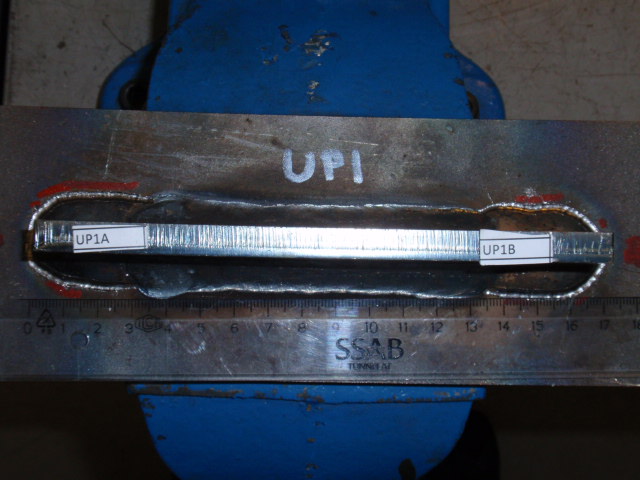History
Forging Innovation: The History of LETS Global
From the craft of hammering welds to AI-driven ultrasonic precision—LETS Global’s journey traces more than a century of engineering progress and a continuing commitment to sustainable strength.
Early Discoveries: Manual Peening and the Birth of Residual Stress Control
At the dawn of modern engineering, shipyard and bridge builders discovered that hammering or peening welds improved fatigue life.
Though empirical at first, this practice introduced compressive residual stresses—a discovery that would eventually define an entire discipline of fatigue engineering.
In the 1940s, John O. Almen transformed peening from a craft to a controlled process with the Almen strip, the first device to measure peening intensity [1].
By the 1960s, hammer and needle peening were standard techniques in shipbuilding and heavy fabrication [2].

A Leap in Frequency: The Birth of Ultrasonic Impact Treatment
In 1972, Soviet researcher Evgeny S. Statnikov developed the first Ultrasonic Impact Treatment (UIT) system [3].
By coupling high-frequency vibration with controlled mechanical impacts, UIT refined the surface microstructure of metals and produced deep, stable compressive stresses—delivering unprecedented improvements in fatigue resistance.
Global Recognition: The 1990s Collaboration
During the 1990s, international collaboration within the International Institute of Welding (IIW)—led by Evgeny S. Statnikov, Peter J. Haagensen, and Luis Lopez Martinez—brought ultrasonic impact treatment to Western academia and industry [4].
Their joint studies demonstrated UIT’s effectiveness on aluminum and high-strength steels, marking the first formal introduction of the technology to the global fatigue-design community.
Scientific Validation: High-Strength Steel Research
In 1997, Luis Lopez Martinez published his Technical Licentiate thesis,
“Fatigue Behaviour of Welded High-Strength Steels” (Report No. 97-30) [5].
The research conclusively showed that ultrasonic peening produces particularly large fatigue-life gains in high-strength welded steels, where compressive stress and high yield strength work synergistically.
This study became a cornerstone reference for applying ultrasonic peening to advanced structural materials.
Building on this foundation, Lopez Martinez, Statnikov, and Haagensen co-authored additional IIW Commission II and XIII papers [6], extending ultrasonic peening research into offshore and energy structures.
Industrialization: The Formation of LETS Global
In the early 2000s, LETS Global was founded to transform this research into industrial practice.
Under Lopez Martinez’s technical leadership, the company developed the first air-cooled ultrasonic peening systems designed for offshore platforms, FPSOs, and renewable-energy structures—solving the safety and practicality issues of liquid-cooled predecessors.
Between 2005 and 2015, LETS Global conducted fatigue-testing programs and field applications confirming that ultrasonic peening could extend the fatigue life of welded offshore joints by four- to ten-fold [7].
These results were validated by independent testing centers and classification societies.
Recognition and Global Dissemination
LETS Global’s offshore applications were showcased internationally:
- Fatigue Life Extension Procedure for Offshore Structures by Ultrasonic Peening – Offshore Technology Conference, Houston (OTC-20368-MS, 2010) [8]
- Structural Integrity and Life Extension of Offshore Installations by Ultrasonic Peening – Brasil Offshore (SPE-142121-MS, 2011) [9]
- Validation by Classification Societies of LETS Global® Life Extension Procedure for Offshore Installations – ResearchGate (2012) [10]
These studies documented how ultrasonic peening could safely “reset” fatigue life on operating offshore assets—an achievement unprecedented at the time.
Integration into International Standards
By the mid-2010s, the process had evolved into the broader class of High-Frequency Mechanical Impact (HFMI) treatments.
The IIW Recommendations for the HFMI Treatment of Welded Joints (2016, 2018) [11] formally recognized ultrasonic peening as a standardized and validated post-weld improvement method, aligning quality assurance and design criteria worldwide.
Looking Ahead – Sustainability, Digitalization & AI Integration
Today, LETS Global continues to advance ultrasonic peening as a key enabler of sustainable engineering and the global energy transition.
For LETS Global, sustainability means prolonging the life of existing assets—reducing the need for new fabrication, cutting raw-material demand, and lowering the carbon footprint of steelmaking and offshore construction.
Each extended year of safe operation represents avoided emissions and supports the circular-economy principle of reuse before rebuild.
The company’s innovation roadmap now embraces:
- Robotic HFMI systems for automated precision treatment,
- Digital process monitoring connected to real-time structural-integrity management, and
- Integration of these data streams with artificial intelligence for predictive fatigue analysis and adaptive optimization.
Through this fusion of sustainability, robotics, digitalization, and AI, LETS Global carries its pioneering legacy forward—delivering intelligent, energy-efficient solutions that enhance safety, extend structural life, and empower the world’s transition to a cleaner, resource-responsible future.
References
- Almen J.O., US Patent 2,350,440 (1942); SAE J443 – Standard Shot-Peening Almen Strip.
- Haagensen P.J. & Maddox S.J., IIW Doc. XIII-1815-00, IIW Recommendations on Post-Weld Improvement Methods (2001/2006).
- Statnikov E.S., Ultrasonic Impact Treatment of Welded Joints, USSR Patent (1972).
- Statnikov E.S., Haagensen P.J., Lopez Martinez L., Introductory Fatigue Tests on Welded Joints in High-Strength Steel and Aluminium Improved by Various Methods Including Ultrasonic Impact Treatment (UIT), IIW Doc. XIII-1748-98.
- Lopez Martinez L., Fatigue Behaviour of Welded High-Strength Steels, Technical Licentiate Thesis, Report No. 97-30 (1997).
- Lopez Martinez L., Statnikov E.S., Haagensen P.J., Ultrasonic Peening of Welded Offshore Structures, IIW Commission II Papers (2000–2005); ResearchGate.
- Lopez Martinez L., Validation by Classification Societies of LETS Global® Life Extension Procedure for Offshore Installations, ResearchGate (2012).
- Lopez Martinez L., Fatigue Life Extension Procedure for Offshore Structures by Ultrasonic Peening, Offshore Technology Conference, Houston (OTC-20368-MS, 2010).
- Lopez Martinez L., Structural Integrity and Life Extension of Offshore Installations by Ultrasonic Peening, SPE-142121-MS, Brasil Offshore (2011).
- Lopez Martinez L., Fatigue Life Extension by Ultrasonic Peening for Offshore Structures – As-Built Weld Quality and Overloads During Remaining Service Life, ResearchGate (2013).
- Barsoum Z. & Marquis G., IIW Recommendations for the HFMI Treatment of Welded Joints, Springer (2016, 2018).
